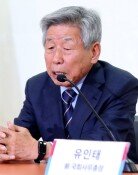12 Trillion Spent on Unemployment Over Last Five Years
12 Trillion Spent on Unemployment Over Last Five Years
Posted September. 21, 2007 07:43,
Although the Ministry of Labor spent some 12.1 trillion won solely to create new jobs over the last five years, the latest findings show that the number of those without jobs soared by 10 percent regardless.
The figures came after Representative Han Sun-kyo of the opposition Grand National Party calculated the total budget allocated to job creation from the 2003-2006 closing accounts of the Labor Ministry and its budget for 2007.
The numbers only reflect the budget of the Labor Ministry. If the calculation includes budgets used by other ministries for the same purpose, the total budget for unemployment during the Roh administration is expected to rise even further, including 10 billion won from the Ministry of Commerce, Industry and Energy on training unemployed engineering graduates and 12.9 billion won from the Small and Medium Business Administration to support small and medium businesses which hire unemployed youth.
However, Han said that the number of the unemployed rose from 752,000 in 2002 to 827,000 last year, up by 10 percent according to data from the National Statistical Office.
The infamous term Sao-jung, used to indicate those in their 40s and 50s who face early retirement, was discovered to be a reflection of the actual statistics of the administration rather than just a social phenomenon. The number of unemployed people between the ages of 40 and 59 jumped by 31.7 percent from 180,000 in 2002 to 237,000 last year. Meanwhile, the number of employed youth between the ages of 15 to 29 declined by 11 percent, from 4.799 million in 2002 to 4.27 million last year.
According to the National Statistical Office data, the number of people employed in service and sales sectors was cut down to about 5.59 million last year from 5.8 million in 2002. The number of beneficiaries of unemployment benefits in the service sector soared by 166.7 percent from 18,059 in 2002 to 48,166 in 2005.
Han pointed out, Although the government expanded its budget on job creation, it made the labor market worse in terms of its quality. The government has been focusing on raising employment in the manufacturing sector, while more and more college graduates actually wish to work in the service sector, where employment is on the decline.
Last year, the top three sectors in the service industry were most adversely affected by shortages of job applicants, with 7.16 percent vacancy rates in transportation, 5.02 percent in culture, arts, design and broadcasting, and 4.84 percent in beauty, accommodation, recreation and sports.
In stark contrast, the Ministry of Labor placed priority on machinery and manufacturing sectors when supporting programs for training the unemployed this year. Among 91 job types to receive support, 41 were machinery-related jobs (45.1 percent) and eight were metal and electronics-related jobs respectively (8.8 percent each).
Many have raised their voices saying the government should train employees in a way that facilitates the needs of employers, as some are suffering from lack of job applicants while the number of employed people is on the decline.
According to National Statistical Office data, employers needed 205,166 more employees last year, whereas the number stood at 149,556 employees in 2002.
ditto@donga.com







